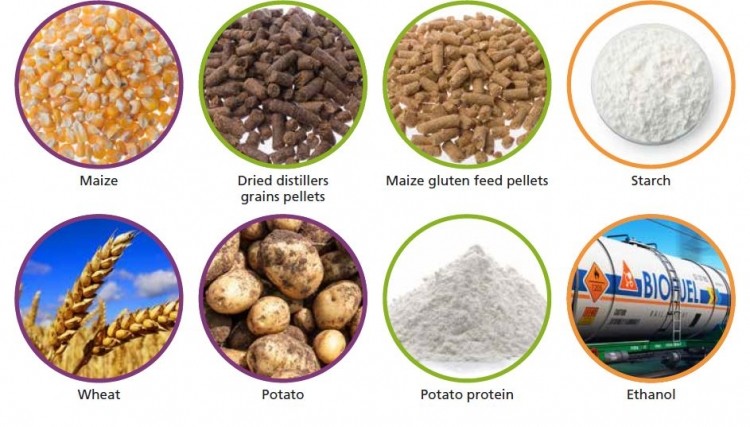EU feed industry's use of co-products highlighted

A publication, Co-products, an essential part of animal nutrition, describes how ingredients such as sugar beet pulp, maize gluten feed, wheat bran and dried distillers’ grains are generated and it shows the value they bring in compound feed.
The European Feed Manufacturers' Federation (FEFAC) said it compiled the report to press home to EU stakeholders and policymakers the extensive use of co-products by the EU feed industry and the role the sector plays in the food chain’s circular economy, which it said tends to be overlooked.
The use of co-products fits the fundamental ethos of the EU compound feed industry, delivering the most cost-effective feed resources, where possible using elements that would otherwise go to waste, said the industry representatives.
“There is a strong desire from within the FEFAC membership to better explain what compound feed manufacturers do.
"The example of converting co-products into nutritious animal feed is a key element of the role we play in the circular economy and we would like to create more awareness about it.
"We hope that this publication illustrates how livestock farming and non-animal food production are interlinked. Indirectly, compound feed manufacturing is far more part of daily food production than people generally know," Nick Major, FEFAC president, told FeedNavigator.
Nutritional needs and life stage matching
Farmed animals, especially ruminants, have the unique capacity of being able to use the co-products of arable product processing that are not consumed by people as food or drink, or used to produce biofuels or other industrial products, continued FEFAC.
Indeed, a 2017 study by the UN’s Food and Agriculture Organization (FAO), published in Global Food Security, also highlighted how livestock rely primarily on forages, crop residues and co-products that are not edible to humans. That paper showed how 86% of the global livestock feed intake in dry matter consists of feed materials that are not currently edible for humans.
Anne Mottet, livestock development officer, FAO, said she realized that people were continually being exposed to incorrect information about livestock and the environment that is repeated without being challenged, in particular about livestock feed. The FAO led study was about addressing those kind of discrepancies and providing peer-reviewed evidence to inform policymakers and the public, she said.
Animal nutrition science
Animal nutrition science is used to extract nutritional and economic value from co-products and to formulate them into high-performing feedstuffs for farmed animals; that process involves analyzing the nutritional components available in co-products, then matching them with the physiological and nutritional requirements of farm animals at specific life stages, according to the report.
“Few other sectors so rigorously identify and reuse resources resulting from other manufacturing processes,” stressed FEFAC, citing the example of the co-product, brewers’ grains, which it said have no role in human consumption but, because of animal nutrition science, have become a valuable feed material.
Indeed, the report identifies how brewers’ grains are rich in proteins and highly digestible fiber, making them particularly beneficial to cattle and other ruminants. The fiber supports the functioning of the rumen, complementing forage-based diets that are high in starch and lack readily fermentable fiber, noted the review. With crude protein content ranging from 19–31% on a dry matter basis, brewers’ grains are also a good source of protein, it said. However, due to their high moisture level, brewers' grains are perishable, so livestock activity in the proximity of a brewery is also desirable.
“Ensuring that secondary materials such as brewers’ grains and brewers’ yeast have a sustainable outlet as protein, fiber and vitamin-rich animal feed is integral to the brewing sector’s constantly improving environmental performance,” said beer industry group, The Brewers of Europe.
Processed animal protein legislation
The FEFAC report also highlighted how meat industry co-products, processed animal proteins (PAPs) from non-ruminant livestock, approved for use in aquaculture since 2013, are particularly suitable for inclusion in the feed of carnivorous fish such as salmon.
“PAP contains essential amino acids, including lysine and methionine, as well as fats and minerals such as calcium and phosphorous. It is also highly palatable and digestible for fish, and has no anti-nutritive constituents.
“At the time of writing, a further lifting of the feed ban introduced in 2001 is under discussion. The next possible relaxation regards the use of pork PAP in poultry diets and poultry PAP in pig diets. An essential precursor to this is the effectiveness of controls based on analytical tests to verify the identity of particular types of PAP.”
Upgrading quality of feed materials
FEFAC also made it clear in the report that it wants to encourage, and, where possible, assist suppliers of co-products to reach next-level awareness and manage their manufacturing processes to optimally preserve and even upgrade the nutritional quality of the materials destined for feed.
“The value of co-products as feedstuffs depends on producers maintaining their nutritional integrity and safety when producing, handling, storing and transporting them – in other words, treating them like ’products’ and not as discarded ‘waste’.”
















